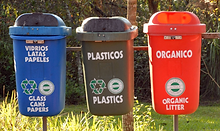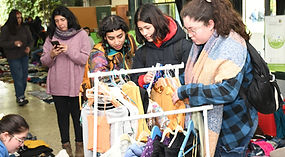Argentina
- Written by Zahira
Which kind of waste bins do you have in your household?

Recycling bins at Iguazú Falls, Argentina. (Image: Alamy/ Mike Walker).
Argentina uses a mixed household waste system, separating organic/non-recyclable materials with and recyclable waste. Many cities, like Buenos Aires, use color-coded bins for recyclables such as paper, plastic, metal, and glass. However, practices vary widely by location, and infrastructure is inconsistent. While some areas support recycling through waste picker cooperatives, open dumps are common, highlighting the need for better facilities and nationwide adoption of sorting practices.

What would you say is the general attitude toward secondhand clothing in your country?
According to Kantar (2023), 48% of Argentines bought or sold secondhand clothing at least once in the last year, and over 60% of those who shop secondhand are between 18 and 35 years old. The trend shows that responsible consumption is becoming a generational habit.
The rise of circular fairs, the growing secondhand market, and the creativity of entrepreneurs show that there is willingness to change. The next step is for the government, companies, and society to come together and create a system that transforms textile waste into economic, social, and environmental opportunities.
Where do people usually buy or sell secondhand clothes?
Projects like Feria Circular and Renová tu Vestidor are good examples of textile upcycling events, as they organize itinerant events across cities, promoting the idea of circular fashion. These fairs not only keep clothes in circulation but also encourage youth entrepreneurship, as many people sell what they no longer wear or even reworked garments.

UACh students organized the first feria de moda circular, showcasing sustainable clothing and upcycled designs. (Image: Diario UACh.)
What is one thing that your country could learn from Malaysia/ U4B?
Argentina has no national legislation on textile waste management, and insufficient infrastructure for large-scale fiber recycling. U4B’s textile waste management system, principles, and infrastructure is something that Argentina should aspire to have.
Which facts shocked you during your research?
The national textile industry produces more than 1.2 billion garments annually (Fundación ProTejer, 2022). Many are barely worn and discarded quickly, fueled by the fast fashion logic. The result: closets overflowing and landfills overwhelmed.
What are some national campaigns or organizations in your country promoting textile recycling or reuse?
In Argentina, several national and local initiatives promote textile recycling and reuse through collection, upcycling, and circular fashion. NGOs like Cáritas, Fundación Sí, and Red Solidaria collect used clothing and redistribute it to vulnerable communities, while smaller organizations such as DAM Boutique transform everyday textiles like dish towels and sheets into accessories.
A growing network of circular and vintage fairs also plays a key role, with neighborhoods in Buenos Aires like Palermo, Colegiales, and San Telmo are hosting markets where secondhand fashion thrives. Similar events are found in Córdoba’s Güemes fair and Rosario’s La Toma, both combining vintage clothing with community engagement.
Fundación Sí promotes social projects while also working to reduce textile waste. (Image: Rosario3)

What kind of textile waste recycling points exist in Argentina?

Argentina doesn’t have a national system for textile waste collection, but various local initiatives aim to extend the life of used clothing. NGOs like Cáritas, Fundación Sí, and Red Solidaria collect garments for redistribution to vulnerable communities, while “Green Points” in cities like Buenos Aires offer textile bins, with wearable items passed on to social organizations. Some startups and companies, such as Urban Recicla and Tiento, focus on upcycling, and a few fashion brands have introduced in-store collection programs to promote circularity. Despite these efforts, most discarded clothing in Argentina is not recycled and ends up in open-air dumps, landfills, or burned informally which contributes to pollution and environmental harm.
Recycling Center of Buenos Aires: integrated waste treatment and education across five plant facilities. (Image: Buenos Aires City Government / Metropolis)
How much textile waste is generated in Argentina? How much ends up in landfills, how much is recycled?
In Argentina, around 500,000 tons of textile waste are generated every year (INTI, 2023). That’s the equivalent to thousands of trucks filled with clothes that end up in landfills or open dumps.
References
Instituto Nacional de Tecnología Industrial. (2019, February 8). Argentina.gob.ar. https://www.argentina.gob.ar/inti
Inicio - Fundación Pro Tejer. (2025, February 4). Fundación pro Tejer. http://fundacionprotejer.org
Puntos Verdes Móviles | Buenos Aires Ciudad - Gobierno de la Ciudad Autónoma de Buenos Aires. (2025). Buenosaires.gob.ar. https://buenosaires.gob.ar/vicejefatura/ambiente/residuos-especiales/puntos-verdes-moviles
Argentina. (2021). Kantar.com. https://www.kantar.com/latin-america/latinoamerica/argentina
Ambiente. (2018, January 11). Argentina.gob.ar. https://www.argentina.gob.ar/interior/ambiente
I'm a paragraph. Click here to add your own text and edit me

